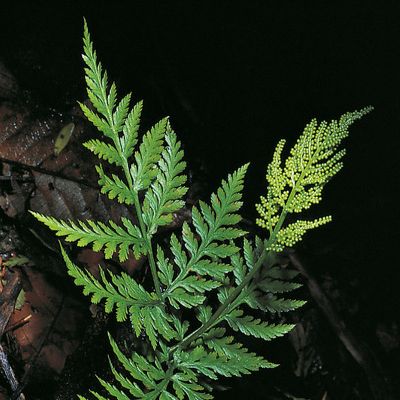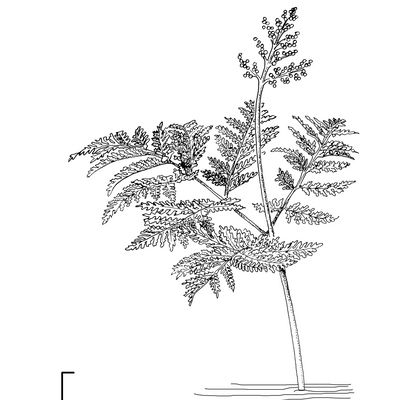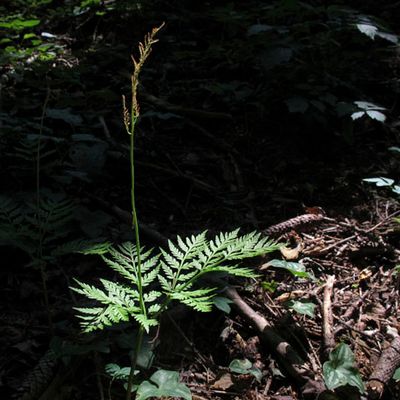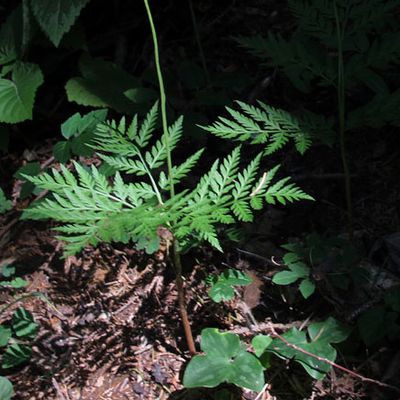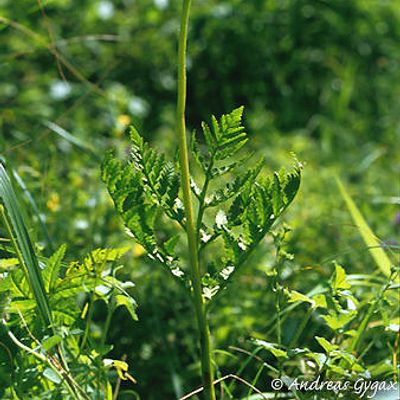Botrychium virginianum (L.) Sw.
1007030
Species
ISFS : 63700
Checklist : 1007030
ISFS : 63700
Checklist : 1007030
Contains :
Synthesis
Species description (© Flora Helvetica 2018)
15-30 cm hoch. Sporangienstand rispig, lang gestielt. Steriler Teil etwa in der Mitte der Pflanze, ungestielt, breiter als lang, 2-3fach gefiedert, mit länglichen, eingeschnitten-gezähnten Abschnitten, zerstreut behaart bis kahl, dünn und schlaff.Flowering period (© Flora Helvetica 2018)
6-8Habitat and distribution inside Switzerland (© Flora Helvetica 2018)
Wälder, schattige Waldwiesen / montan-subalpin / GR, BOWorld distribution (© Flora Helvetica 2018)
Eurosibirisch-nordamerikanisch
Ecological indicator (© Landolt & al. 2010)
3+32-32+3.g.2n=90,180,184Status
IUCN status
Critically endangeredNational Priority
1 - very high national priorityInternational responsibility
2 - mediumConservation
Threats
Frass (Schnecken, Vieh), Tritt
Bautätigkeit (z. B. Waldstrassen nach Sturmschäden), touristische Erschliessung (Wege, Mountainbike-Routen, Rastplätze u. a)
Uferverbauungen
Konkurrenzpflanzen (z. B. Aegopodium podagraria, Chaerophyllum hirsutum), dichtere Vegetation
Bewirtschaftungsänderungen, insbesondere Vergandung, Aufforstungen oder Kahlschläge
Sammeln
Kleine, isolierte Populationen
Distribution map
Habitat and distribution inside Switzerland
GR, BOWorld distribution
Eurosibirisch-nordamerikanisch
Ecology
Life form
Geophyte
Habitats
Milieux Phytosuisse (© Prunier et al. 2017)
Habitats © Delarze & al. 2015
 | 4.3.5 - Borstgrasrasen (Nardion) |
bold
Dominant species, influencing the appearance of the habitat
 Character species
Character species
 Less strictly linked to a specific habitat
Less strictly linked to a specific habitat
Ecological indicator values by © Landolt & al. (2010)
| Soil factors | Climatic factors | Salinity tolerance | |||
|---|---|---|---|---|---|
| Humidity Value H | 3+ | Light Value L | 3 | Salinity Index | -- |
| Reaction Value R | 3 | Temperature factor T | 2+ | ||
| Nutriments value N | 2 | Continentality K | 3 | ||
- Ecological values legend
Humidity Value H 1 very dry 1+ dry 2 moderatly dry 2+ moist 3 medium wet 3+ wet 4 very wet 4+ soggy 5 submerged or underwater f plants living in running water u mostly submerged plants v partly submerged, partly floating plants w humidity moderately variable (± scale of 1-2) w+ highly variable humidity (scale exceeding ± 2) Reaction Value R 1 Very acid (pH 2.5-5.5) 2 acid (pH 3.5-6.5) 3 lightly acid to neutral (pH 4.5-7.5) 4 neutral to basic (pH 5.5-8.5) 5 basic (pH 6-5 -> 8.5 Nutriments value N 1 very low in nutrients 2 low in nutriments 3 medium-poor to medium-rich in nutrients 4 rich in nutriments 5 very rich in nutriments Salinity tolerance 1 halotolerant 3 halophyle Light Value L 1 very shady 2 shady 3 lighted areas 4 luminous 5 highly luminous Temperature factor T 1 alpine to nival stages (from the treeline to the snowline) 1+ suprasubalpine and upper subalpine levels (pine and larch forests) 2 subalpine level (coniferous forests without beeches up to the upper limit of spruces) 2+ lower subalpine and upper mountain stages 3 mountain level (beech and silver fir forests, in the central Alps Scots pine forests) 3+ lower mountain and upper hill levels 4 hill level (mixed deciduous oak forests) 4+ hot places, hill level 5 very hot places, hill level (only in the hottest places, typical of southern Europe) Continentality K 1 Atlantic (high air humidity, very low temperature variations, mild winters) 2 Sub-Atlantic (high air humidity, low temperature variations, relatively mild winters) 3 sub-Atlantic to subcontinental (average air humidity, moderately variable temperature, slightly low winter temperatures) 4 subcontinental (low air humidity, large temperature variations, rather cold winters) 5 continental (very low air humidity, very large temperature variations, cold winters)
Water dependency
| Rivers | 1 - Secondary habitat |
| Calm water | 1 - Secondary habitat |
| Ground water | 0 - No link |
Nomenclature
Accepted Name (Checklist 2017)
Botrychium virginianum (L.) Sw.
Vernacular name
Deutscher Name :
Virginische MondrauteNom français :
Botryche de VirginieNome italiano :
Botrichio virginianoMatch with other reference books
| Relation | Nom | Book | No |
|---|---|---|---|
| = | Botrychium virginianum (L.) Sw. | Checklist 2017 | 63700 |
| = | Botrychium virginianum (L.) Sw. | Flora Helvetica 2001 | 26 |
| = | Botrychium virginianum (L.) Sw. | Flora Helvetica 2012 | 16 |
| = | Botrychium virginianum (L.) Sw. | Flora Helvetica 2018 | 16 |
| = | Botrychium virginianum (L.) Sw. | Index synonymique 1996 | 63700 |
| = | Botrychium virginianum (L.) Sw. | Landolt 1977 | 61 |
| = | Botrychium virginianum (L.) Sw. | Landolt 1991 | 56 |
| = | Botrychium virginianum (L.) Sw. | SISF/ISFS 2 | 63700 |
| = | Botrychium virginianum (L.) Sw. | Welten & Sutter 1982 | 29 |
= The taxon corresponds to the accepted taxon (Checklist 2017)
< The taxon is included in the accepted taxon (Checklist 2017)
> The taxon includes (among others) also the accepted taxon (Checklist 2017)
< The taxon is included in the accepted taxon (Checklist 2017)
> The taxon includes (among others) also the accepted taxon (Checklist 2017)
Status
Native status
-IUCN list of endangered species (© Walter & Gillett 1997) : No
Status on national Red List 2016
IUCN status:
Critically endangered

Additional information
IUCN criteria: C2a(i); D
Status on regional Red List 2019
| Biogregraphic regions | Status | IUCN criteria |
|---|---|---|
| Jura (JU) | -- | |
| Mittelland (MP) | -- | |
| Alpennordflanke (NA) | CR | C2a(i); D |
| Alpensüdflanke (SA) | RE | |
| Östliche Zentralalpen (EA) | CR | C2a(i); D |
| Westliche Zentralalpen (WA) | -- |
- Legend
EX Extinct RE Regionally Extinct CR(PE) Critically Endangered, Probably Extinct CR Critically Endangered EN Endangered VU Vulnerable NT Near Threatened LC Least Concern DD Data Deficient NE Not Evaluated NA Not Applicable
National Priority Species List Status
| National Priority | 1 - very high national priority |
| Need to take action | 2 - |
| International responsibility | 2 - medium |
| Need to monitor populations | 2 - |
Protection status
| International (Bern Convention) | No | |
| Cantonal | -- | |
| Switzerland | total protection |
- Disclaimer
InfoFlora compiles information on protected species as accurately as possible, taking it from the respective cantonal laws. In some cases, however, it was not possible to use the plant names as listed in the original text, but an interpretation of their taxonomy or nomenclature was necessary. The exact meaning of the categories „completely protected“ and „partially protected“ differs among the cantons.
InfoFlora cannot guarantee that the information on the protection status is correct and complete. In case of doubts, we recommend to look up the texts of the respective cantonal law.
Status by sector of activity
| Agriculture-related environmental objectives : | more informations | |
| Forest management environmental objectives : | Z - | more informations |
Conservation
Threats and measures
Frass (Schnecken, Vieh), Tritt
Bestände einzäunen
Individuen mit Drahtgeflecht schützen
Bautätigkeit (z. B. Waldstrassen nach Sturmschäden), touristische Erschliessung (Wege, Mountainbike-Routen, Rastplätze u. a)
Priorität der Fundstellen vor Bau- und Freizeitvorhaben
Uferverbauungen
Auencharakter der Vegetation erhalten
Konkurrenzpflanzen (z. B. Aegopodium podagraria, Chaerophyllum hirsutum), dichtere Vegetation
Reduktion der unmittelbaren Konkurrenzpflanzen von Hand
auflockern der Vegetation
Bewirtschaftungsänderungen, insbesondere Vergandung, Aufforstungen oder Kahlschläge
Extensive Bewirtschaftung beibehalten (Waldnutzung, extensive Weide), Vegetation darf nicht zu dicht werden
Sammeln
Präzise Fundstellen nur den zuständigen Fachstellen bekanntgeben
Kleine, isolierte Populationen
Schutz aller Populationen (Mikroreservate)
alljährliche Überwachung der aktuellen Fundstellen, periodisches Absuchen der erloschenen Vorkommen
Dauerflächen einrichten
Detailkartierung resp. regelmässiges Monitoring (Methode PopCount)
Erfolgskontrolle der Massnahmen gewährleisten
